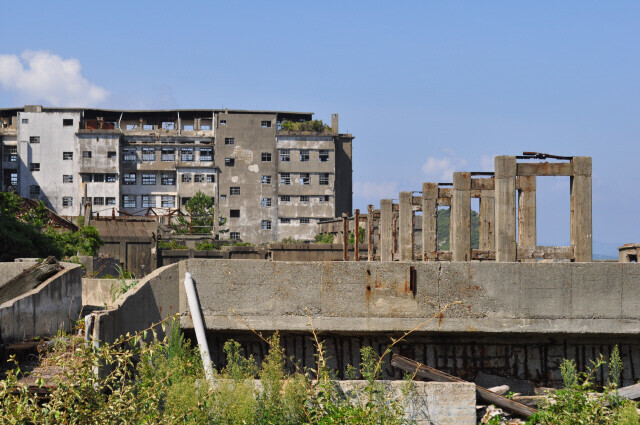hankyoreh
Links to other country sites 다른 나라 사이트 링크
What are Japan’s UNESCO World Heritage sites at center of dispute between S. Korea-Japan?

Facilities from Japan’s industrial revolution registered on UNESCO’s World Heritage list are the subject of an ongoing diplomatic brawl between South Korea and Japan. This World Heritage site includes 23 facilities scattered across eight Japanese prefectures, including the Mitsubishi shipyard in Nagasaki, that were part of the industrial revolution that swept across Japan from the Meiji Restoration in the late 1860s until 1910.
These industrial facilities emerged as the focus of a sharp diplomatic dispute between the two countries when the Japanese government started attempting to register them as a UNESCO World Heritage site in January 2014. The issue erupted when Koreans learned that Hashima Island, also known as Battleship Island, in Nagasaki Prefecture, was one of those facilities. Koreans had learned about Hashima Island through “The Crows,” a novel by Han Su-san published in 2003.
According to a 2012 report by a Korean committee that seeks to aid the victims of compulsory mobilization during the Japanese colonial occupation and investigate the harm they suffered, between 500 and 800 Korean forced laborers were employed at an underwater coal mine near the island in 1944. In addition, cremation permits located by Japanese civic groups confirmed that at least 122 Koreans died on the island between 1925 and 1945.
That naturally provoked strong opposition among Koreans against giving World Heritage status to Hashima Island, with its painful history of Koreans being pressed into forced labor. After much diplomatic wrangling, South Korea and Japan ultimately reached a compromise, with South Korea promising not to oppose the facilities’ addition to the World Heritage list as long as Japan acknowledged that Koreans had performed forced labor there.
Koreans accepted the argument that even sites with dark pasts — such as the Auschwitz concentration camp, which was registered with UNESCO in 1979 — deserve to be on the World Heritage list.
That prompted an acknowledgment by Kuni Sato, Japan’s ambassador to UNESCO at the time, that Koreans had been mobilized “against their will” and “forced to work” at some industrial facilities, including Hashima Island, in the 1940s. Sato made that acknowledgment during the 39th meeting of the UNESCO World Heritage Committee in Bonn, Germany, on July 5, 2015, while also promising to remember the victims by building an information center.
But when the information center opened in Tokyo in June 2020, it turned out that the Japanese government hadn’t kept its promise, rekindling its diplomatic dispute with Korea.
Another issue that has prompted criticism more recently, though not when the industrial sites were first registered with UNESCO, is the inclusion of Shokasonjuku Academy, which serves as a shrine to Japanese intellectual Shoin Yoshida (1830-1859). The academy is located in Hagi, a city in Yamaguchi Prefecture, the birthplace of some of the leading figures in the Meiji Restoration.
The issue is that Shokasonjuku was registered with UNESCO even though it’s not really an industrial facility. Furthermore, Shoin’s fellow students at the academy include Hirobumi Ito, Aritomo Yamagata, and Masatake Terauchi, who played a leading role in Japan’s annexation of Korea and aggressive expansion into Asia.
In short, the desires of former Prime Minister Shinzo Abe and other members of the Japanese right-wing to relive Japan’s “glory days” in the Meiji Restoration had a major influence on registering these facilities from Japan’s industrial revolution with UNESCO.
By Gil Yun-hyung, staff reporter
Please direct comments or questions to [english@hani.co.kr]

Editorial・opinion
![[Column] Season 2 of special prosecutor probe may be coming to Korea soon [Column] Season 2 of special prosecutor probe may be coming to Korea soon](https://flexible.img.hani.co.kr/flexible/normal/500/300/imgdb/original/2024/0426/3317141030699447.jpg) [Column] Season 2 of special prosecutor probe may be coming to Korea soon
[Column] Season 2 of special prosecutor probe may be coming to Korea soon![[Column] Park Geun-hye déjà vu in Yoon Suk-yeol [Column] Park Geun-hye déjà vu in Yoon Suk-yeol](https://flexible.img.hani.co.kr/flexible/normal/500/300/imgdb/original/2024/0424/651713945113788.jpg) [Column] Park Geun-hye déjà vu in Yoon Suk-yeol
[Column] Park Geun-hye déjà vu in Yoon Suk-yeol- [Editorial] New weight of N. Korea’s nuclear threats makes dialogue all the more urgent
- [Guest essay] The real reason Korea’s new right wants to dub Rhee a founding father
- [Column] ‘Choson’: Is it time we start referring to N. Korea in its own terms?
- [Editorial] Japan’s rewriting of history with Korea has gone too far
- [Column] The president’s questionable capacity for dialogue
- [Column] Are chaebol firms just pizza pies for families to divvy up as they please?
- [Column] Has Korea, too, crossed the Rubicon on China?
- [Correspondent’s column] In Japan’s alliance with US, echoes of its past alliances with UK
Most viewed articles
- 1After election rout, Yoon’s left with 3 choices for dealing with the opposition
- 2AI is catching up with humans at a ‘shocking’ rate
- 3Noting shared ‘values,’ Korea hints at passport-free travel with Japan
- 4Two factors that’ll decide if Korea’s economy keeps on its upward trend
- 5Why Kim Jong-un is scrapping the term ‘Day of the Sun’ and toning down fanfare for predecessors
- 6South Korea officially an aged society just 17 years after becoming aging society
- 7Korea’s 1.3% growth in Q1 signals ‘textbook’ return to growth, says government
- 8Is Japan about to snatch control of Line messenger from Korea’s Naver?
- 91 in 5 unwed Korean women want child-free life, study shows
- 10[Reportage] On US campuses, student risk arrest as they call for divestment from Israel